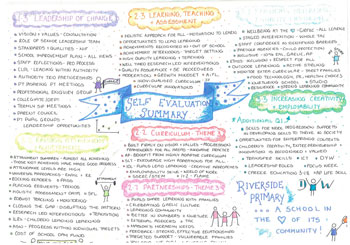Parent, pupil and partner engagement in School Improvement Planning in Riverside Primary School
What was done?
Background
Riverside Primary have embedded termly 'Big Sip' meetings into the life of the school. These meetings are an opportunity for children, staff, parents and wider community members to be actively involved in school improvement planning and in the strategic direction of the school. Each pupil group is represented at the meeting and they in turn report back to their classes. All children have an opportunity to comment and be consulted on the SIP at weekly class Achievement Afternoons.
Creating the School Improvement Plan
 For the past few years, the consultation stages of the School Improvement Plan have taken into account the views of all staff and pupils prior to starting the academic year. Time is set aside during collegiate sessions for staff to identify and share their views on what they deem to be important in moving the school forward successfully. Staff are encouraged to openly discuss their ideas based on background research, local initiatives and school attainment data. Staff views are gathered in a variety of different ways which are then collected by the Senior Leadership Team for analysis.
For the past few years, the consultation stages of the School Improvement Plan have taken into account the views of all staff and pupils prior to starting the academic year. Time is set aside during collegiate sessions for staff to identify and share their views on what they deem to be important in moving the school forward successfully. Staff are encouraged to openly discuss their ideas based on background research, local initiatives and school attainment data. Staff views are gathered in a variety of different ways which are then collected by the Senior Leadership Team for analysis.
The main areas identified are then shared with pupils and families for further investigation. The model used for this can vary from year to year depending on the focus of the improvement plan, however, their input is always fundamental to the process. An example of gathering the views of children was the 'coloured dot' charts that was used in session 2015-2016. Children in the school received three coloured dots and were invited down to the school improvement corridor to place them on the three most important areas that they felt could be developed.
Download larger version of image PDF file: wall display (1.6 MB)
When all areas of consultation have taken place, the school improvement plan for the forthcoming year is generated and shared with staff, pupils and parents. This year the school introduced sketchnoting as a visual representation of this.
Creating our action plans:
Each area of the school improvement plan becomes the responsibility of a promoted member of staff and often a pupils representative group. The individuals meet initially to discuss what their role will be in taking an action forward and will then create their own action plan to display on their pupil board, again sketchnoting has been used to share this process. Throughout the year aspects of this action plan will be worked on and evaluated accordingly.
Big SIP meetings:
 When all action plans are in place and the school improvement plan is underway for the session, representatives, staff members and families were invited along to the 'Big SIP meetings'. These meetings, set up formally like a boardroom, are an opportunity for each member to share their progress/next steps of their action plan. Early in the year these are predominantly led by the promoted member of staff within the group, however, as the year goes on the children take on full responsibility of this and speak with great confidence about the issues relating to their group. A wide range of family members attend these meetings in order to gain an overview of the priorities being taken forward. This opens up effective dialogue between pupils and families in a forward-thinking environment. These meetings take place four times per year. The local secondary school headteacher also attends these meetings to forge links between the schools around improvement priorities.
When all action plans are in place and the school improvement plan is underway for the session, representatives, staff members and families were invited along to the 'Big SIP meetings'. These meetings, set up formally like a boardroom, are an opportunity for each member to share their progress/next steps of their action plan. Early in the year these are predominantly led by the promoted member of staff within the group, however, as the year goes on the children take on full responsibility of this and speak with great confidence about the issues relating to their group. A wide range of family members attend these meetings in order to gain an overview of the priorities being taken forward. This opens up effective dialogue between pupils and families in a forward-thinking environment. These meetings take place four times per year. The local secondary school headteacher also attends these meetings to forge links between the schools around improvement priorities.
It is crucial that the school's aims are visual for all and therefore a whole corridor has been dedicated to school improvement in the main building. These visual displays are a daily reminder of our goals and help the children to make links to what is happening within their own learning. Each classroom also has a 'pupil participation' board where miniature versions of our priorities are displayed and where pupils can give their ideas about particular aspects of the school.
Download larger version of image PDF file: Sketchnote (1.7 MB)
Why was it done?
This project came about to ensure that the school improvement plan was a purposeful and productive tool in leading the school forward to excellence.
What was the impact?
This project has been successful in opening up wider effective dialogue around the importance of school improvement planning. It has supported the school through significant changes, ensuring that effective learning and teaching remains at the heart of everything. It has encouraged all stakeholders to speak openly about change and to know that their input is valued.
Pupil and parents have a strong understanding of the need to be involved in this work and this is now developing with wider community partners.
This work has been constantly evaluated through Big SIP meetings by inviting all stakeholders to report back on the progress/next steps of their identified target. This is also an opportunity for families and other professionals to ask questions based on the reports given from staff and pupils.
These meetings allow Riverside to have flexibility over the improvement plan with the understanding that if progress is not being made then it can be adapted.
In taking forward the improvement plan for the next session, the school plan to extend the invitation to the Big SIP meetings to external agencies, including wider professionals, local businesses and community groups. Riverside is part of Founders4Schools and have a strong focus on supporting children to developing skills for life, learning and work. Therefore, it is crucial to create links to the world of work within the improvement plan in order to support the future aspirations of all young people.
Riverside will also continue to think creatively around sharing the school improvement plan with all stakeholders, ensuring that it is a working model used to benefit the outcomes for all.
How to use this exemplar to improve practice
Advice for those who wish to use this example to improve practice:
- Start small – the most effective programmes come when adaptions can be made freely. Pupils need time to get used to the formality of the meetings and what is expected of them.
- High quality discussions around school improvement planning are vital.
- Regular meetings allow for more flexibility.
- Keep staff, pupils, parents and partners updated with any progress.
Improvement questions
- How do your pupils help to shape your school improvement plan?
- How well do you engage parents and partners in identifying school priorities?
